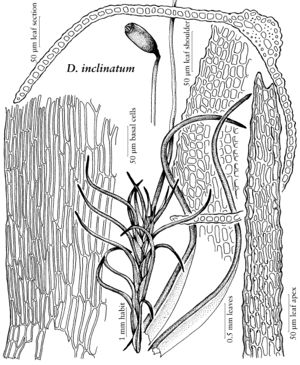Difference between revisions of "Distichium inclinatum"
Bryol. Europ. 2: 157. 1846,.
FNA>Volume Importer |
FNA>Volume Importer |
(No difference)
| |
Revision as of 19:40, 24 September 2019
Stems to ca. 3 cm, mostly shorter. Sexual condition autoicous. Seta to 2 cm, straight to somewhat flexuose, smooth, red or reddish brown, occasionally yellowish brown. Capsule brown, 1–1.5 mm, inclined, ovoid, becoming ± wrinkled when dry; operculum to 0.3 mm; peristome evenly spaced, lanceolate, divided nearly to the base into 2(–3) filaments, smooth to papillose or sometimes ± striolate. Spores densely and finely papillose, occasionally roughened, 30–45(–48) µm.
Phenology: Capsules mature summer–fall.
Habitat: Calciphilic, sandy soils, rocks, ledges
Elevation: low to high elevations
Distribution
Greenland, Alta., B.C., Man., N.B., Nfld. and Labr., N.W.T., Nunavut, Ont., Que., Yukon, Alaska, Calif., Colo., Mich., Minn., Mont., Nev., N.Y., N.Dak., Utah, Wis., Wyo., Mexico, Europe, Eurasia, e, c, n Asia, Arctic.
Discussion
Distichium inclinatum is similar to D. capillaceum and D. hagenii, differing from the former in the inclined, ovoid capsule, shorter stems, more closely set leaves, and larger spores. It differs from the latter primarily by features of the peristome: the peristome teeth of D. hagenii have a basal membrane and the teeth are arranged in eight irregular but separated groups of two teeth each, rather than being evenly spaced as in D. inclinatum and D. capillaceum.
Selected References
None.
